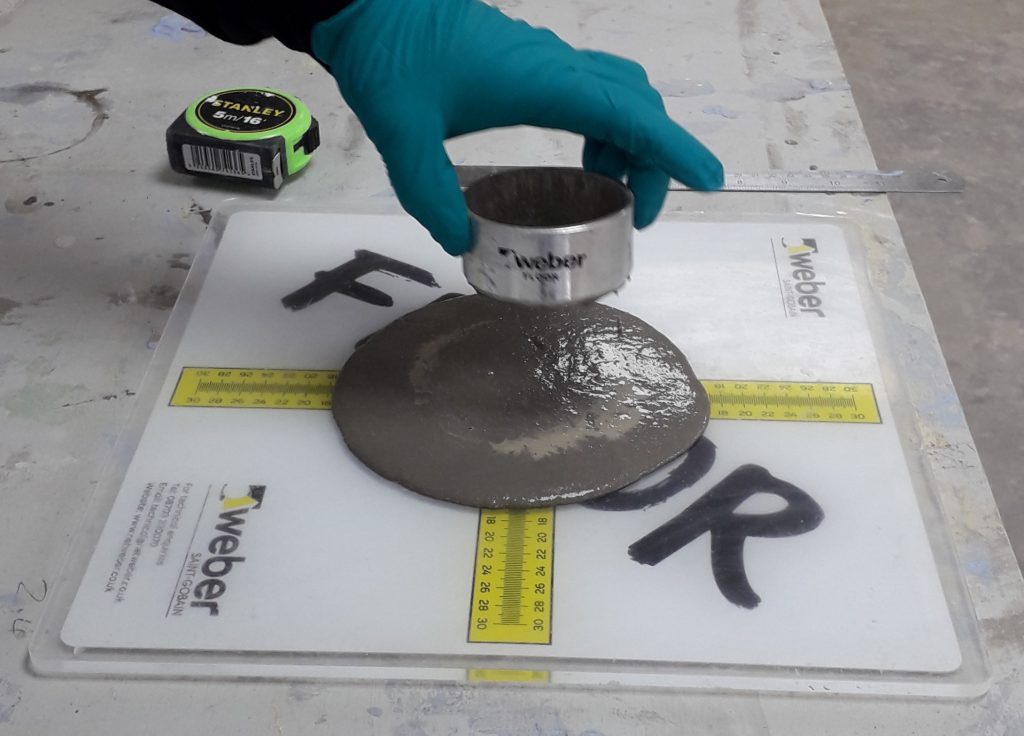
Feeling floored with Saint-Gobain Weber tips
Rob Speke, technical academy manager at Saint-Gobain Weber, offers advice on the dos and don’ts of preparing substrates and applying floor screeds.

Do: Get rid of dust
The best way to prepare a substrate is to always remove dust first. You might need to grind or shotblast it depending on how poor the substrate is. For this, you’ll need a good brush and a hoover to remove dust.
Do: Prime the substrate
Priming is crucial – the substrate will need to be primed at least twice. The recommendation is that you brush the primer in.
Some people don’t brush (they might use atomisers) but the problem with that is it doesn’t get into the pores of the substrate, which can create a lot of air bubbling. It can also reduce the flowability of any good screed.

You should prime the project the night before you plan on applying the screed, come in the next morning and give it a quick lick over again with the primer.
I’d advise using weberfloor 4716 primer, an acrylic floor primer for use with all cementitious and hemi-hydrate floor screeds. By the time you’ve set up your machine and prepped everything the primer will have soaked in sufficiently.
You shouldn’t really be leaving it longer than 36 hours. This is because you’re going to have problems with dust particles and people walking over the primed floor.
Do: Put measures in place to prevent cracking
Regardless of if it’s a thin screed, like weberfloor smooth 4150, or a base screed, such as weberfloor fibre rapid 4320, there should be a 10mm soft foam barrier placed around all walls, pillars and columns.
Anywhere the screed meets another rigid object, there’ll be different expansions. This can cause hairline cracking – using a 10mm soft foam perimeter barrier can help stop this from happening.
Do: Get the room temperature right
Temperatures are critical too. The room you are screeding needs to be above 8°C but below 25 °C.
High humidity in a room means the screed won’t dry very quickly. Open up a window or a door slightly to help ventilate the room. You need some air change in the room but you don’t want them open so wide that you get a ripple effect on the screed.
Do: Keep it clean
Put a couple of used empty bags in the doorway to wipe your feet on once you’ve finished the room. If you don’t do this, you’ll end up walking screed all through the house, on the lawn and in your van.
Don’t: Get ahead of yourself
A common mistake people make is that they get so excited about starting a job that they don’t prepare properly. One minute they are happily pumping floor screed and the next they’re stuck in a corner screaming for a bucket to put the hose in. Make sure you understand the geography of the building you’re working on.
Don’t: Forget to flow test
Another mistake people tend to make is they’ll set up the machine to run, make the relevant checks and then think they never have to do another flow test. However, what they have to understand is that the machine will wear and tear slightly throughout the operation.
To ensure materials are mixed correctly, a flow ring measurement is essential both before and during a screed application.
A flow test should be carried out every tonne or 15 minutes, whichever comes first, for the first hour and then every 20 minutes if results are stable.

Don’t: Cut corners on the last square metre
The most critical point of any screed installation is the last square metre. This is because it’s the last thing you do when you’re tired and trying to complete the job and leave. It’s also the first metre the customer sees.
It is the most important point of any floor because if your customer sees a terrible finish in that last metre they’re going to be very critical of the rest of the floor. If that’s in good order, then the chances are everything else will be.
For more information on Saint-Gobain Weber’s flooring systems, visit the website.
Click here to read a Saint-Gobain Weber guide that supports specifiers with the flooring process.
Saint-Gobain Weber
Dickens House, Enterprise Way
Maulden Road
Flitwick
Bedford
MK45 5BY
UK
Visit Saint-Gobain Weber's website
Visit Supplier's page
Latest news

28th March 2025
Ideal Heating Commercial announces 10-year warranty on Evomax 2 boiler
Evomax 2, the UK’s number one selling commercial wall-mounted boiler from Ideal Heating Commercial, is now available with a 10-year warranty.
Posted in Articles, Building Industry News, Building Products & Structures, Building Regulations & Accreditations, Building Services, Facility Management & Building Services, Heating Systems, Controls and Management, Heating, Ventilation and Air Conditioning - HVAC, Innovations & New Products, Pipes, Pipes & Fittings, Plumbing, Retrofit & Renovation, Sustainability & Energy Efficiency, Videos
28th March 2025
FLIR Si1-LD Acoustic Imaging Camera for Compressed Air Leak Detection
FLIR, a Teledyne Technologies company, introduces the Si1-LD, an industrial acoustic imaging camera that brings faster and more accurate compressed air leak detection to those operating on a modest condition monitoring budget.
Posted in Acoustics, Noise & Vibration Control, Articles, Building Industry News, Building Products & Structures, Building Services, Facility Management & Building Services, Information Technology, Innovations & New Products, Retrofit & Renovation, Sustainability & Energy Efficiency, Thermal Imaging and Monitors
28th March 2025
LIFTEX 2025 Seminar programme announced
Registration has opened for LIFTEX 2025. Now in its 37th year, LIFTEX 2025 is the UK’s only dedicated exhibition for the lift, escalator and access industry and takes place only once every three years.
Posted in Access Control & Door Entry Systems, Accessibility, Articles, Building Industry Events, Building Industry News, Building Products & Structures, Building Regulations & Accreditations, Building Services, Exhibitions and Conferences, Facility Management & Building Services, Health & Safety, Retrofit & Renovation, Security and Fire Protection, Seminars
28th March 2025
MCRMA welcomes ArcelorMittal UK to membership
A UK division of the global steelmaking business ArcelorMittal has become the latest new member of the MCRMA, the industry association representing the metal building envelope sector.
Posted in Articles, Building Associations & Institutes, Building Industry News, Building Products & Structures, Building Systems, Cladding, Facades, Posts, Restoration & Refurbishment, Retrofit & Renovation, Roofs, Steel and Structural Frames, Walls
 Sign up:
Sign up: